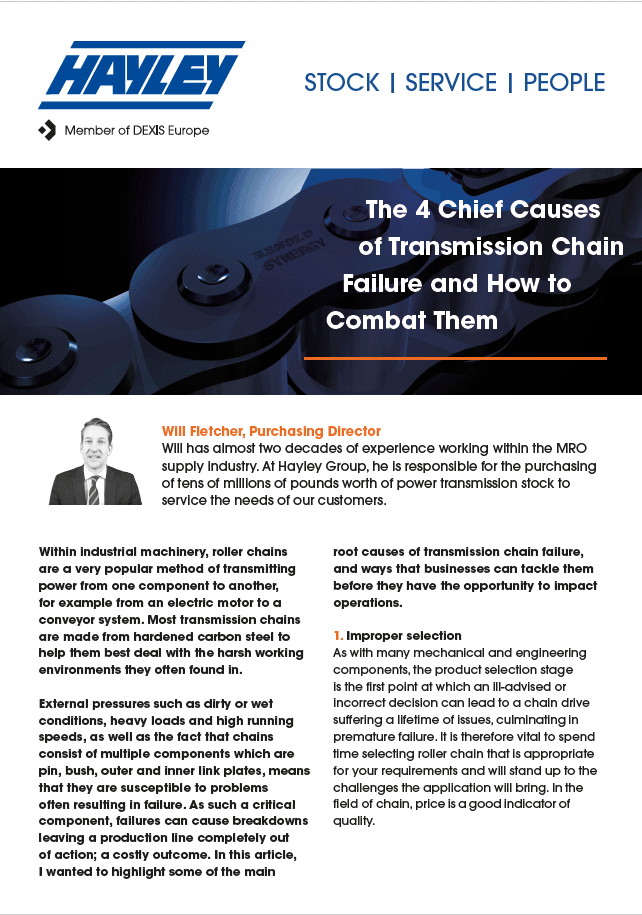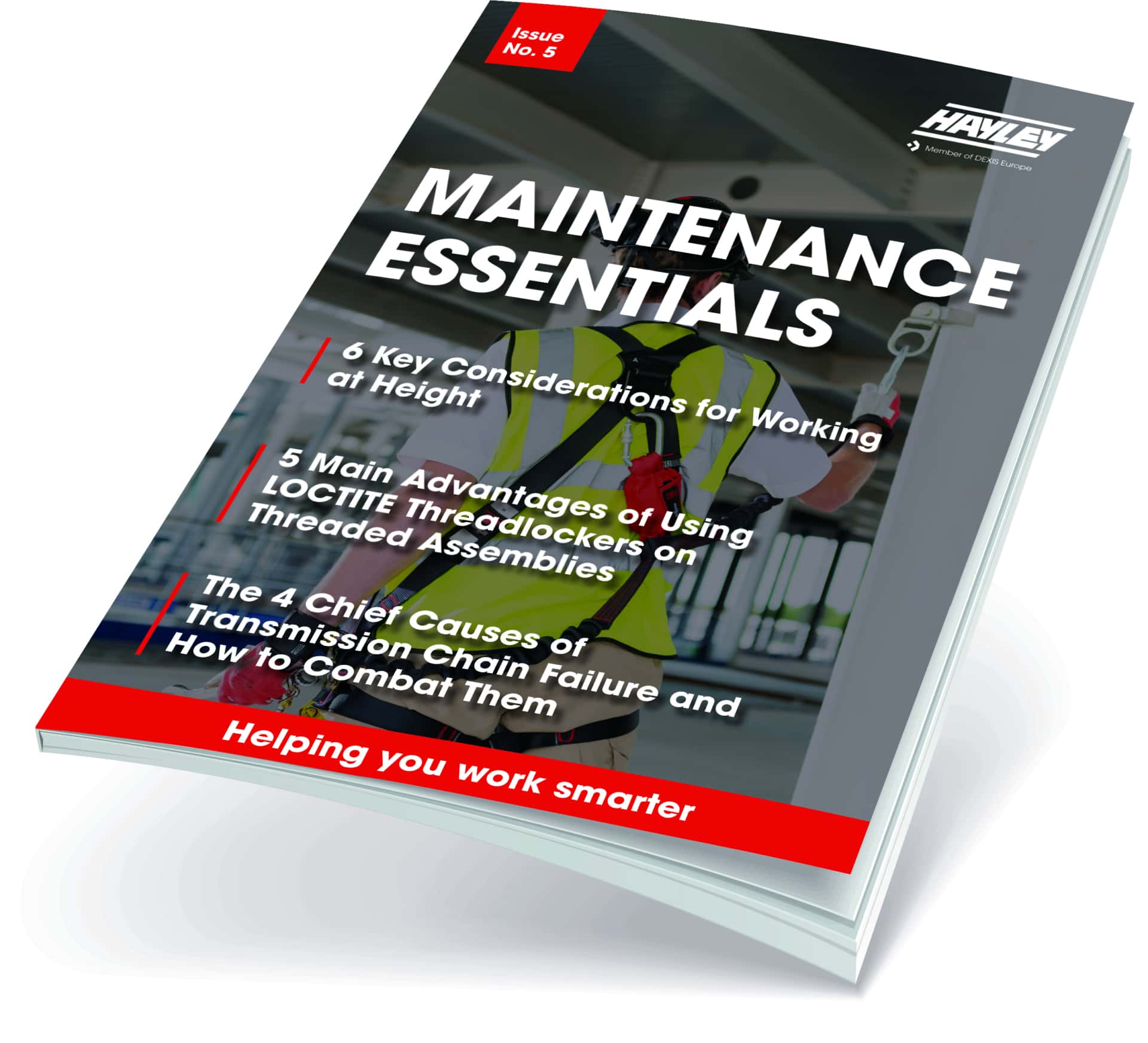Will Fletcher, Purchasing Director
Will has almost two decades of experience working within the MRO supply industry. At Hayley Group, he is responsible for the purchasing of tens of millions of pounds worth of power transmission stock to service the needs of our customers.
Within industrial machinery, roller chains are a very popular method of transmitting power from one component to another, for example from an electric motor to a conveyor system. Most transmission chains are made from hardened carbon steel to help them best deal with the harsh working environments they often found in.
External pressures such as dirty or wet conditions, heavy loads and high running speeds, as well as the fact that chains consist of multiple components which are pin, bush, outer and inner link plates, means that they are susceptible to problems often resulting in failure. As such a critical component, failures can cause breakdowns leaving a production line completely out of action; a costly outcome.
In this article, I wanted to highlight some of the main root causes of transmission chain failure, and ways that businesses can tackle them before they have the opportunity to impact operations.
1. Improper selection
As with many mechanical and engineering components, the product selection stage is the first point at which an ill-advised or incorrect decision can lead to a chain drive suffering a lifetime of issues, culminating in premature failure. It is therefore vital to spend time selecting roller chain that is appropriate for your requirements and will stand up to the challenges the application will bring. In the field of chain, price is a good indicator of quality.
Low price chain is a false economy. The old adage “buy cheap, buy twice” definitely applies here and those charged with sourcing such items should be suspicious of chain that is available at such a low price point as the quality of materials and the structural integrity of the chain will be almost certainly compromised. The advice here would be to purchase only from reputable manufacturers and distributors. For instance, RENOLD was the very first chain manufacturer in the UK to achieve ISO 9001:2015 accreditation, and this gives businesses using their products the reassurance that their products have been subject to the highest level of quality management processes. By buying from a reputable name, via an established distributor like Hayley Group, customers also have access to unrivalled technical support and know-how to help them at every stage from guidance at the point of purchase to trouble-shooting during the product’s service life.
2. Improper installation
Once the appropriate product has been purchased, the next point in the process where businesses can help to prevent premature failure of their transmission chain is at the installation stage. Equipment must be thoroughly checked and prepared, including the cleanliness of sprocket teeth, in advance of mounting, with all general transmission requirements also identified correctly. All measurements must be completely accurate, with the use of a spirit level and micrometer being highly recommended, especially in the alignment of parallel shafts and sprockets.
Once in place, to cater for any variability in the installation process, the adjustment of the chain should always be tried through one complete revolution of the largest sprocket. The overall advice is to follow manufacturer guidance at all times, especially at the initial installation stage. To protect the chain from possible contaminants, present in the environment (e.g., dust or dirt particles), and therefore avoid premature failure and any unplanned downtime, partitions can be installed.
To avoid contamination causing issues for your chain drive, appropriate lubrication is also a vital weapon in your arsenal. This brings us on to my next point.
3. Improper lubrication
Improper lubrication is the single biggest risk factor behind premature failure in chains, accounting for around 60% of failures. Lubricant selection is fundamental in ensuring roller chain is adequately lubricated with a product that both enables its efficient operation and helps to protect it from contaminants including moisture. Retaining compliance with any applicable hygiene standards must also be considered at this point. In most cases, good quality, non-detergent petroleum-based oil is the go-to lubricant for chain, with viscosity requirements dictated by ambient temperature. For applications experiencing abnormal temperatures, manufacturer recommendations are available. Heavy oils and greases are generally not able to reach all of the chain’s working surfaces and are therefore not recommended for use.
There are a handful of different methods that are commonly used to apply lubricants to transmission chain, with the best method determined by the chain speed and amount of power being transmitted. Manual lubrication is perhaps the most obvious method, where the oil should be applied periodically using a brush or oil can. Application by this method should focus on keeping the chain wet, which may mean relubricating every eight hours of operation.
Drip lubrication can be employed as a method where oil drips are directed between the link plate edges from a drip lubricator. Both volume and frequency should be adequate to allow penetration into the chain joints. Bath or disc lubrication can also be used, with the lower strand of the chain running through a sump of oil in the drive housing. The oil level should cover the chain at its lowest point during operation.
Disc lubrication also uses an oil bath, however for this method, the chain operates above the oil level, with the disc picking-up and depositing the oil onto the chain using deflection plates. Finally, stream lubrication is another option and facilitates a continuous supply of oil from a circulating pump or central lubricator system. Holes from where the oil is dispensed must be aligned with chain edges and the oil must be delivered to the chain before it engages with the drive sprocket.
4. Improper Maintenance
Effective inspection and maintenance procedures are vital to ensuring the efficient running of and extending the service life of all mechanical components, and chain is no exception. Mean Time Between Failure (MTBF) is a widely-recognised measure of reliability and is a measurement that is critical to power transmission systems, and maintenance should have the aim of keeping this as low as possible.
There are several symptoms that chain tends to show, that can be identified during an inspection which can be diagnosed, and in turn, remedied. All before a failure can cause a breakdown. Many troubleshooting guides are readily-available online and via manufacturers for engineers looking to resolve issues quickly. These guides include solutions for common problems such as rusting, elongation (sometimes referred to as “stretch”), excessive wear on the sprocket teeth surfaces, and fracturing of link plates, and are therefore highly-valuable reference tools for maintenance professionals.




